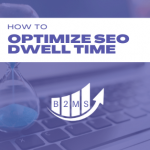4 areas of website optimization for more reach and contact inquiries
There are countless ways to optimize a website. In this article, I want to focus on four different areas to increase reach and generate more leads in the long run.
- Tech-Set-Up and measurability
- Search Engine Optimization (SEO)
- Content Marketing
- Website conversion rate optimization

Optimize tech set-up and measurability of a website
Nowadays, certain standards are required like a secure connection via HTTPS protocols. Your website should definitely use an SSL certificate.
In addition, good and fast hosting and website infrastructure should be in place. Creating a website is easier than ever due to drag-and-drop website builders like WordPress, Squarespace, or Wix. It is not only about a good design, but also the best possible user experience for website visitors.
Unfortunately, as a marketing consultant, I find that people want to “improve” their website, SEO, advertising, or digital marketing in general without having any data available. You can’t drive a car without a dashboard.
Therefore, the following or equivalent webmaster tools should be implemented: Google Search Console, Google Analytics, LinkedIn Insights Tag for B2B companies, HubSpot tracking code for marketing automation.
SEO Website Optimization
At the time of publishing this blog post, I have already written over 26 articles on SEO-specific topics on Back2MarketingSchool. What I’m saying is that SEO can be a very complex topic. I’ll give a brief overview below that you should consider and research in more detail if necessary.
First things first, SEO is not just keywords on a page:
Page Speed optimization.
The loading time of a website is important because on the one hand visitors don’t wait until a page is completely loaded if it takes too long, and on the other hand, because search engines like Google consider loading times in their algorithm. So a slow site can hurt you twice.
Here are 5 tips to optimize your page speed:
- Use plugins or tools to optimize like NitroPack or WPRocket
- Optimize the images: new formats and file sizes
- Use as little custom code as possible and only necessary plugins
- Combine tags/pixels in a container tag like Google Tag Manager
- Compress CSS and JavaScript files
On-Site SEO Optimization
As already mentioned, loading times also influence SEO results and are part of the on-site SEO category, as well. Therefore, your website should always be optimized in terms of page speed for desktop and mobile.
On-page SEO is an essential component of your SEO strategy. A healthy website is the foundation on which your keywords and content marketing is built.
You can get a free website scan to determine your website health without any obligations:
Furthermore, metadata such as the SEO title, H1 headings, and meta description belong to the category of on-page SEO. While many technical errors can creep in there, this is as much an opportunity to strategically place SEO keywords.
Each page or blog post should be optimized with respect to one primary and a maximum of one additional secondary keyword. This requires keyword research.
There are several methods of keyword research and I have already described some comprehensively:
- Google Search Console Keyword Research
- For local businesses Google My Business Insights
- Advanced keyword tools like SEMRush
Another aspect that covers two points at the same time is internal cross-links. On the one hand, they serve the purpose to send signals to Google and Co to emphasize the importance of an internal page and on the other hand, they ensure user-friendliness. Let’s take the link in this section as an example. You can learn more about internal linking without having to search for a resource.
The last point I want to make is the so-called E-A-T (Expertise, Authoritativeness, and Trustworthiness). Simply put, it is important to signal authority and expertise to the reader and search engines. There are several factors that can help with this. Here are a few:
- Add a description of the author to articles
- Link to external resources when they provide a source or supplement
- Link to social media profiles
Content marketing for website optimization
Content marketing and SEO go hand in hand when it comes to website optimization. Here is a brief overview of points that are important in content marketing:
- Always keep content current and relevant. If something is no longer relevant, take the content offline or update old blog posts.
- Optimize your content with respect to a keyword. Often website owners just write away without paying attention to SEO.
- Add images, paragraphs, and subheadings.
- More content! In the end, more content is always better than less content (as long as the content doesn’t compete with each other through keyword cannibalization).
Website Conversion Rate Optimization
In most cases, websites have the goal to convert visitors. In order to have the highest conversion rate possible, each page should have only one goal and therefore only one call-to-action (CTA).
The CTA should be clearly recognizable and also visually distinguishable from the rest of the content. A different color for a CTA button is a good option.
In addition, it is important to measure the conversion rate and continuously improve it through testing.
Short forms convert better than longer ones. Therefore, only ask for the information you really need.
Another optimization option is to implement a chatbot. Chatbot Conversational Marketing can double the conversion rate of a website.

Sascha is a Lifecycle Marketing Consultant with over 8 years of digital marketing experiences in Silicon Valley, the UK, and Germany.
After leading the demand generation for a 100+ million company, he decided to venture out on himself. He’s now helping clients to attract and convert more leads and customers.
His main focus are SEO, paid media & marketing automation – all with the focus to tie marketing campaigns to revenue.
Sascha has been featured in industry publications.



